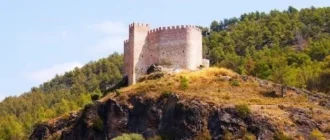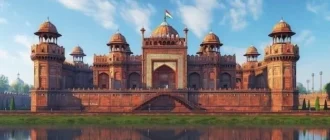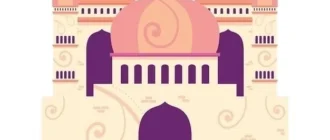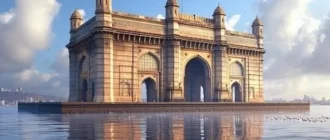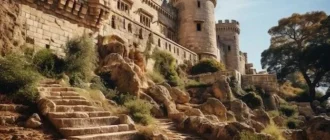Introduction: Moroni – A Cultural Tapestry
Nestled in the azure waters of the Indian Ocean, Moroni, the capital of the Comoros, invites exploration of its captivating cultural heritage. Influenced by Arab, African, and French traditions, the city is a vibrant tapestry of architectural wonders, historical treasures, and lively customs. This journey will unveil the hidden gems of Moroni, offering a glimpse into the soul of Comorian identity.

The Architectural Legacy: Mosques and Medinas
Moroni’s skyline is gracefully punctuated by the towering minarets of its numerous mosques, serving as a testament to the island’s deep-rooted Islamic faith. These architectural marvels, often adorned with intricate carvings and calligraphy, are not merely places of worship but also serve as social hubs for the community. The Grand Mosque of Moroni, an emblem of Islamic heritage in Comoros, stands as a beacon of spirituality and architectural grandeur.
A stroll through the labyrinthine alleys of Moroni’s medina, the historic heart of the city, is akin to stepping back in time. The medina’s narrow, winding streets are flanked by ancient buildings, their whitewashed facades adorned with intricately carved wooden doors and balconies. This architectural style, reminiscent of coastal towns in East Africa and the Middle East, speaks volumes about the island’s rich trading history and the cultural confluence it fostered. The air is thick with the aroma of spices, and the vibrant colors of fabrics and local crafts displayed in the souks add to the sensory tapestry of the medina.
The architectural legacy of Moroni extends beyond religious and historical structures. The city’s modern buildings often incorporate traditional Comorian design elements, creating a harmonious blend of old and new. The use of local materials, such as volcanic rock and coconut palm wood, further strengthens the link between architecture and the island’s natural environment.

The Comoros National Museum: A Window to the Past
The Comoros National Museum, located in the heart of Moroni, stands as a testament to the archipelago’s rich and multifaceted history. This cultural institution serves as a custodian of the nation’s heritage, housing a diverse collection of artifacts that narrate the story of the Comoros from ancient times to the present day.
Within the museum’s walls, visitors embark on a captivating journey through time. Ancient pottery shards and tools provide insights into the lives of the island’s earliest inhabitants, while intricate carvings and jewelry showcase the artistic skills of subsequent generations. Exhibits dedicated to the colonial period shed light on the cultural exchange and societal transformations that occurred during this era.
The museum’s collection extends beyond historical artifacts to encompass a wide range of cultural expressions. Traditional costumes, musical instruments, and household objects offer glimpses into the everyday lives and customs of the Comorian people. The museum also houses a collection of manuscripts and documents that provide valuable insights into the evolution of the Comorian language and literary traditions.
Through its carefully curated exhibits, the Comoros National Museum provides a comprehensive and engaging exploration of Comorian heritage, fostering a deeper understanding and appreciation for the island nation’s unique cultural tapestry.

Exploring Comorian Identity: Language and Traditions
Comorian identity is a rich tapestry woven from diverse cultural influences, most prominently reflected in the nation’s languages and enduring traditions. The linguistic landscape of the Comoros is a testament to its history as a crossroads of trade and cultural exchange. Shikomori, a Bantu language with Arabic, French, and Malagasy influences, serves as the lingua franca, binding the islands together through shared heritage.
Beyond Shikomori, Arabic and French, legacies of colonial history and religious ties, hold official language status, further enriching the linguistic diversity of the Comoros. Arabic, deeply intertwined with the nation’s Islamic faith, resonates within mosques and religious gatherings, while French maintains its presence in administrative and educational spheres.
Comorian traditions, passed down through generations, provide a glimpse into the soul of the islands. Music and dance play a central role in cultural expressions, with vibrant rhythms and energetic movements reflecting the archipelago’s African, Arab, and Malagasy heritage. Traditional ceremonies, such as weddings and religious festivals, offer immersive experiences into Comorian customs, often characterized by colorful attire, intricate henna designs, and communal feasting.
Hospitality, a cornerstone of Comorian culture, is evident in the warmth and generosity extended towards visitors. Sharing food and engaging in conversation are highly valued, fostering a sense of community and interconnectedness that lies at the heart of Comorian identity.

The Vibrant Arts Scene: Festivals and Celebrations
The cultural tapestry of Moroni is woven with vibrant threads of artistic expression, brought to life through a calendar brimming with festivals and celebrations. These joyous occasions offer a captivating glimpse into the soul of the Comorian people, showcasing their deep-rooted traditions, artistic talents, and infectious joie de vivre.
One such celebration is the Comoros International Film Festival, an annual event that transforms Moroni into a hub of cinematic artistry. Filmmakers, actors, and enthusiasts from across the globe converge to celebrate the power of storytelling, showcasing a diverse range of films that shed light on global perspectives and cultural nuances.
Equally captivating is the Contemporary Arts Festival, a vibrant showcase of Comorian creativity in its myriad forms. From traditional music and dance performances to contemporary art exhibitions, the festival transforms the city into a dynamic platform for artistic exploration and cultural exchange.
Religious festivals, deeply intertwined with the Islamic faith, hold a special significance in Moroni’s cultural calendar. Eid al-Fitr, marking the end of Ramadan, and Eid al-Adha, commemorating the Prophet Ibrahim’s willingness to sacrifice his son, are occasions for families and communities to come together in prayer, feasting, and shared celebrations. During these festivals, the streets of Moroni come alive with vibrant decorations, traditional attire, and the joyous sounds of celebration.

The Flavors of Comoros: A Culinary Journey
A culinary journey through Moroni is a sensory adventure that unveils the diverse flavors and aromatic spices that define Comorian cuisine. Influenced by a rich blend of Arab, African, and French culinary traditions, the island’s cuisine tantalizes the palate with its unique blend of spices, fresh seafood, and tropical fruits.
One of the cornerstones of Comorian cuisine is the generous use of aromatic spices, infusing dishes with layers of flavor. Cinnamon, cloves, cardamom, and saffron are among the staples, adding warmth, depth, and complexity to both savory and sweet dishes. Coconut milk, a versatile ingredient, lends a creamy richness to curries, stews, and desserts, while fragrant herbs, such as cilantro and mint, provide refreshing bursts of flavor.
Fresh seafood, naturally, features prominently in Comorian cuisine, given the archipelago’s island location. Grilled fish, often seasoned with a blend of spices and herbs, is a staple, while curries and stews often incorporate prawns, crab, or lobster.
No culinary journey through Moroni would be complete without savoring the island’s abundance of tropical fruits. Mangoes, pineapples, bananas, and papayas, often enjoyed fresh, also find their way into desserts, juices, and smoothies.

Engaging with the Local Community: Hospitality and Customs
Engaging with the local community in Moroni is an enriching experience that reveals the true heart of Comorian culture. The warmth and hospitality of the Comorian people are renowned, and visitors are often embraced with open arms and genuine smiles.
Respect for local customs and traditions is paramount when interacting with the community. A common greeting involves a handshake with the right hand, accompanied by a sincere inquiry about one’s well-being. It is considered polite to address elders and authority figures with respect, using appropriate titles.
Sharing food is a fundamental aspect of Comorian hospitality. Visitors are often invited to partake in meals, and it is considered a gesture of appreciation to accept the offering with gratitude.
When visiting mosques or homes, it is customary to remove one’s shoes as a sign of respect. Modest dress is also appreciated, with women often covering their heads and shoulders. Photography should be approached with sensitivity, and it is always polite to ask permission before taking photos of people or religious sites. By embracing the local customs and approaching interactions with a spirit of respect and openness, visitors can forge meaningful connections with the people of Moroni and create lasting memories of their Comorian journey.

Conclusion: Moroni – A Cultural Oasis in the Indian Ocean
As the sun sets over the turquoise waters of the Indian Ocean, casting a warm glow on the minarets and rooftops of Moroni, one cannot help but be captivated by the city’s enduring charm. This journey through the cultural gems of Moroni has unveiled a world of architectural wonders, historical treasures, and vibrant traditions, all woven together by the warmth and hospitality of the Comorian people.
From the towering minarets of its mosques to the labyrinthine alleys of its medina, Moroni’s architectural legacy stands as a testament to its rich and layered past. The Comoros National Museum offers a captivating glimpse into the archipelago’s history, while the vibrant arts scene, with its festivals and celebrations, showcases the soul of the Comorian people.
The flavors of Comorian cuisine, a delightful fusion of Arab, African, and French culinary traditions, tantalize the palate, while the warmth and generosity of the local community leave a lasting impression on the heart.
Moroni is more than just a capital city; it is a cultural oasis, a testament to the enduring power of tradition, and a vibrant tapestry of human connection waiting to be explored.

